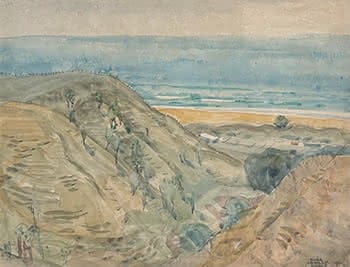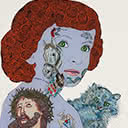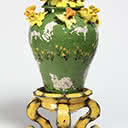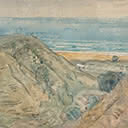Untitled Landscape
43.5 x 57 cm
est. $2,000 - 4,000
In contemplating the history of art in New Zealand, it would be difficult for The Group not to come to mind. Formed in Christchurch in the late-1920's, The Group was an ever-evolving artist collective that exhibited for fifty years. Independence and autonomy were fundamental to its formation, in contrast to the conservatism of dominant exhibiting institutions of the era. The prior celebrated style was naturalistic, and traditional landscape painting reigned supreme.
It was against this backdrop that The Group developed a reputation for fostering both modernity and the unconventional in art. Without championing a specific style or subject, members were united in their flair for experimentation and enthusiasm in their work. Given this innovative spirit, it comes as no surprise that five of the original seven members were young women. By their third annual exhibition in 1929, the ratio of female artists grew to 7-2. As a collective that is largely attributed with shaping the New Zealand modernist movement, the depth of impact from female artists cannot be understated. The Group's lasting significance is a testament to the women who established its very foundations.
Evelyn Page (1899-1988) was one of these founding artists. Her painting practice explored landscapes, figure and still-life studies that were characterised by lively brushwork and an expressive palette.
Travelling to Europe and Britain undoubtedly had an impact on her works, as with many other artists in The Group who were exposed to international movements like fauvism and cubism overseas. Young Woman in a Bay Window (1982), echoes Ingres' The Valpinçon Bather, embracing a post-impressionistic painterly application whereby contrasting swathes of colour dance across the canvas in fluid strokes. Influences from abroad are also found throughout the works of French-born Louise Henderson (1902-94), who joined The Group in the early 1930's. Paintings like Ponsonby Girls incorporate a cubist-like approach, whereby the figures are formed using fragmented features and angular brushwork.
A number of Page and Henderson's contemporaries joined in subsequent years, each moving away from merely imitating reality in their paintings to develop their own distinctive styles. Many celebrated female artists were involved in The Group across decades, such as Rita Angus (1908-70) who was a long-standing member from 1932 until the 1960's. Angus, alongside other influential members Olivia Spencer-Bower (1905-82) and Rata Lovell-Smith (1894-1969), were amongst those leading the regionalist movement during the mid-century, often turning to landscape subjects in an array of approaches that captured local identity and a distinguishable sense of place. Spencer-Bower for example, was particularly known for her mastery of the watercolour medium. Her earlier works incorporate more naturalistic drawings of scenes around the Southern region, built up using thin washes of paint in a layered approach. She later developed a looser, more abstract painterly technique.
Untitled Landscape sits somewhere between the two, exemplifying the delicacy and subtle sense of movement that characterised her painting. In later years, contemporary artists such as Gretchen Albrecht (b.1943) made their own unique contributions to The Group and upheld the spaces that the women who came before them had carved out. A candid photograph taken by Olivia Spencer-Bower in 1936 pictures members of The Group in discussion, three of whom have paintings in hand, including Louise Henderson and Rata Lovell-Smith. Not only does the photograph capture the very spirit of the artist collective through the eyes of a female artist, but it proudly centres the contributing women who were integral to its formation and lasting influences.
MADELEINE GIFFORD





